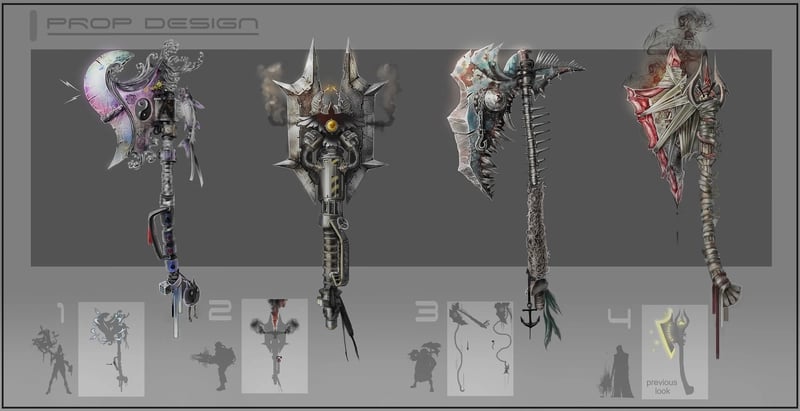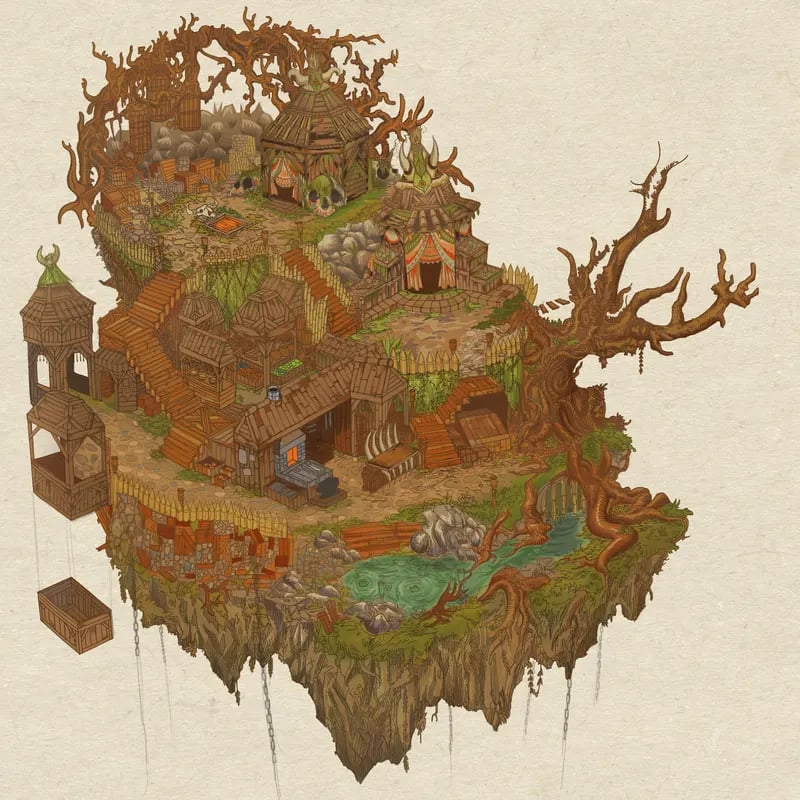Concept art is a creative and challenging career. While there are many fantastic job opportunities as a concept artist, there’s also a lot of competition, even for entry-level positions. So, how do you get ahead? An impressive concept art portfolio is crucial to getting noticed by potential employers. We'll take you through some of the things you need to consider when building your concept art portfolio and give you tips on ensuring your work stands out (for the right reasons)!
Your hard work will be worth it—concept artists have opportunities to work on some incredible projects in the entertainment industry and often get to witness their drawn concepts translated into real-life or digital 3D characters, props, vehicles, sets, and environments!
Creating an impressive concept art portfolio
What we’ll cover:
What is a concept art portfolio?
A concept art portfolio is a digital or physical compilation of artwork that showcases an artist's skills and abilities in the creation of conceptual art and their capacity to think creatively. This can include illustrations, sketches, 3D renderings, and other pieces that help to visualize an idea or concept. Work can include both commissioned and personal projects.

Concept art sketches (of the cover image of this blog post) by Xin Liu. Including the process/progress of your art can be a good addition to your portfolio.
Concept art portfolio layout and formatting
Before choosing your work, you need to consider how you will showcase it. Whether it’s printed or digital, a good portfolio template will act as a strong foundation on which you’ll add your work.
Portfolio layout and formatting tips:
- If showing your work digitally, select a platform that allows you to update your work easily and quickly, like ArtStation, The Rookies, or Behance
- Order your pieces into categories. If presenting your work as a PDF, use the chapter format; if creating a portfolio website, use image galleries.
- For videos, use Vimeo—the video quality is better than YouTube, and you have the ability to update your content
- Don’t overcrowd your homepage—only include five images maximum.
- Optimize your images for the medium you're using, and ensure all images load properly. If your page is heavy with images, use thumbnails that you can click on and enlarge—this will help your page load faster and can look neater.
- Ensure your images are at a decent resolution so potential employers can see the level of detail in your work.
A well-organized portfolio is the first step towards standing out from the competition and landing the job you want. It also makes it easier to curate your work (and update as required), which is the next vital step.
 Esther Wu's concept art portfolio website. Esther is a concept artist (Call of Duty Black Ops IIII, Destiny 2: Forsaken, Forza 6) and CG Spectrum mentor. Note that they only included a total of three images on their homepage.
Esther Wu's concept art portfolio website. Esther is a concept artist (Call of Duty Black Ops IIII, Destiny 2: Forsaken, Forza 6) and CG Spectrum mentor. Note that they only included a total of three images on their homepage.
Curating work for your concept art portfolio
Your concept art portfolio should only contain your strongest and most polished work. These can include works in progress, but they must be your best.
Make sure your portfolio pieces reflect the type of work you want to do. For example, do you want to be a character designer? Then, include character art. Perhaps you want to focus on fantasy games or films? If so, ensure your imagery reflects this genre.
How to select and refine art for your portfolio:
- What type of work are you trying to get hired for? If you are targeting a specific job or industry, take a look at the job listing or industry guidelines, as well as any films or games they've worked on, and select examples of your work that fit those requirements.
- Focus on quality over quantity and, if necessary, revise older work to bring it up to your current standards.
- Maintain a level of consistency to demonstrate direction and focus and create cohesion for viewers. This may mean centering on one art genre.
- If your work has yet to be sold for commercial use, create your own mock-ups of how it would look in various formats.
You will need to tailor your portfolio to match the industry, studio, and/or project you are hoping to work on, which often means updating it regularly and accordingly.

Prop design concept art by CGS student Shweta Raj
Including an introduction in your concept art portfolio
Remember that your concept art portfolio is not just selling your work, it’s also selling you as an artist. Use your words to paint a picture of who you are so that potential employers or clients want to learn more.
What to include in your introduction:
- Why you (want to) specialize in the area that you do?
- Any formal training (CG Spectrum offers expert led concept art courses)
- Notable clients and any recognition you’ve received
- If you have a portfolio website or blog, you can include relevant links. This will give potential employers or clients a way to learn more about you and your work.
- A personal touch (e.g., your hobbies or interests outside of concept art)
Be clear, concise, and professional but also keep in mind that your concept art portfolio is not your LinkedIn profile—you can be a bit more personable.

Environment design concept art by Joseph Merlou
Including a rationale behind your concept art
Many potential employers will want to know the thought process behind a piece of work, so you'll need to be able to provide some context. Explain the idea, rationale, brief, etc.
Information to include about your art:
- The title of the piece
- The date you finished it
- The media used
- The dimensions of the work, if applicable
- If it was art for a client, include who commissioned it
You can also include any notes on your process. This will give potential employers a better understanding of how you approach your art.

Reviewing your work (before publishing it)
Attention to detail matters to potential clients. Before publishing or printing your portfolio, check for any errors. Then check it again. And again!
Get a couple of mentors or friends to review your portfolio and look for any issues (spelling, formatting, resolution, etc.). If you're a CG Spectrum student, book an appointment with our career coach to review your portfolio or make some time with your industry mentor to look over it. This will help to see your work from a fresh perspective, and they may notice things you’ve missed.
Keep practising and creating art!
The only way to improve as an artist and build a stronger portfolio is by constantly working on new pieces and expanding your skills. However, this is easier said than done! One of the biggest challenges for any artist is staying motivated to keep practising their art.
Five tips for staying motivated as a concept artist:
- Set realistic goals for yourself. Don't try to accomplish too much at once, especially if you're just starting out. Focus on one thing you want to improve at a time, and gradually increase the amount as you get better.
- Find a mentor or someone with a keen eye who will give you feedback on your work. Constructive criticism can help you improve your skills much faster than trying to figure everything out on your own. (Did you know that CG Spectrum's concept art degree and the concept art specialization course dedicate an entire trimester/term to building your portfolio and job skills, and it's led by an industry-experienced concept artist who will review your portfolio and suggest improvements?)
- Take some time to appreciate your progress. Find pieces that you are proud of. Remind yourself why you liked those pieces in the first place, and think about how you've grown as an artist since then.
- Put in place an achievable routine and stick to it. Even thirty minutes a day will help make you a better artist in the long run.
- Don’t compare yourself to others. The key to staying motivated is to focus on the progress you have made rather than the progress others have made.
 A perfect example of progress! CGS concept art grad Nikita improved immensely through dedication, hard work, and the support and guidance of an experienced concept artist as her mentor.
A perfect example of progress! CGS concept art grad Nikita improved immensely through dedication, hard work, and the support and guidance of an experienced concept artist as her mentor.
Ready to create an impressive concept art portfolio?
Building a stand-out concept art portfolio is a key step towards getting a job as a concept artist for film and games!
By enrolling in CG Spectrum's online concept art courses, you will gain hands-on experience creating compelling concepts and narrative images. Learn expert Adobe Photoshop techniques and how to work with client briefs, producing high-quality work that you can include in your concept art portfolio. You'll get personalized advice and feedback on your work from your industry-experienced mentor and can seek additional career support from CG Spectrum's in-house career development team.
Build your concept art portfolio with the guidance of industry pros!
Related Links

